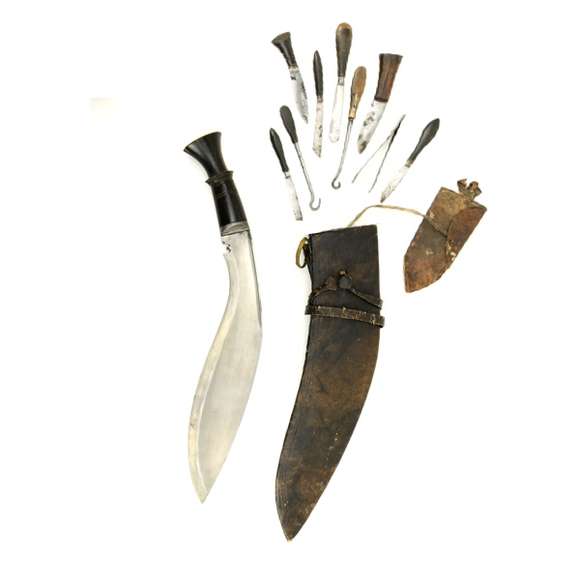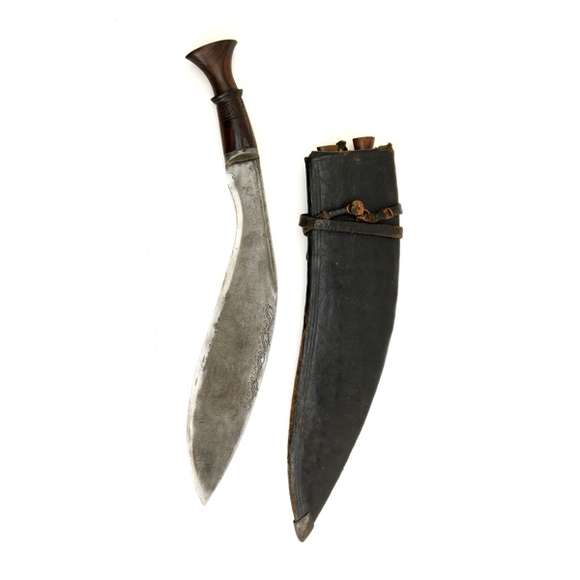Language: Nepali
Source: In common use / a 1931 dictionary
Description
The khukurī (खुकुरी) is the traditional utility and fighting knife of Nepal. It is strongly associated with the Ghurkas, a Nepalese soldier class.
Khukurī are characterized by a forward curving blade that widens considerably before forming a fairly sharp point.
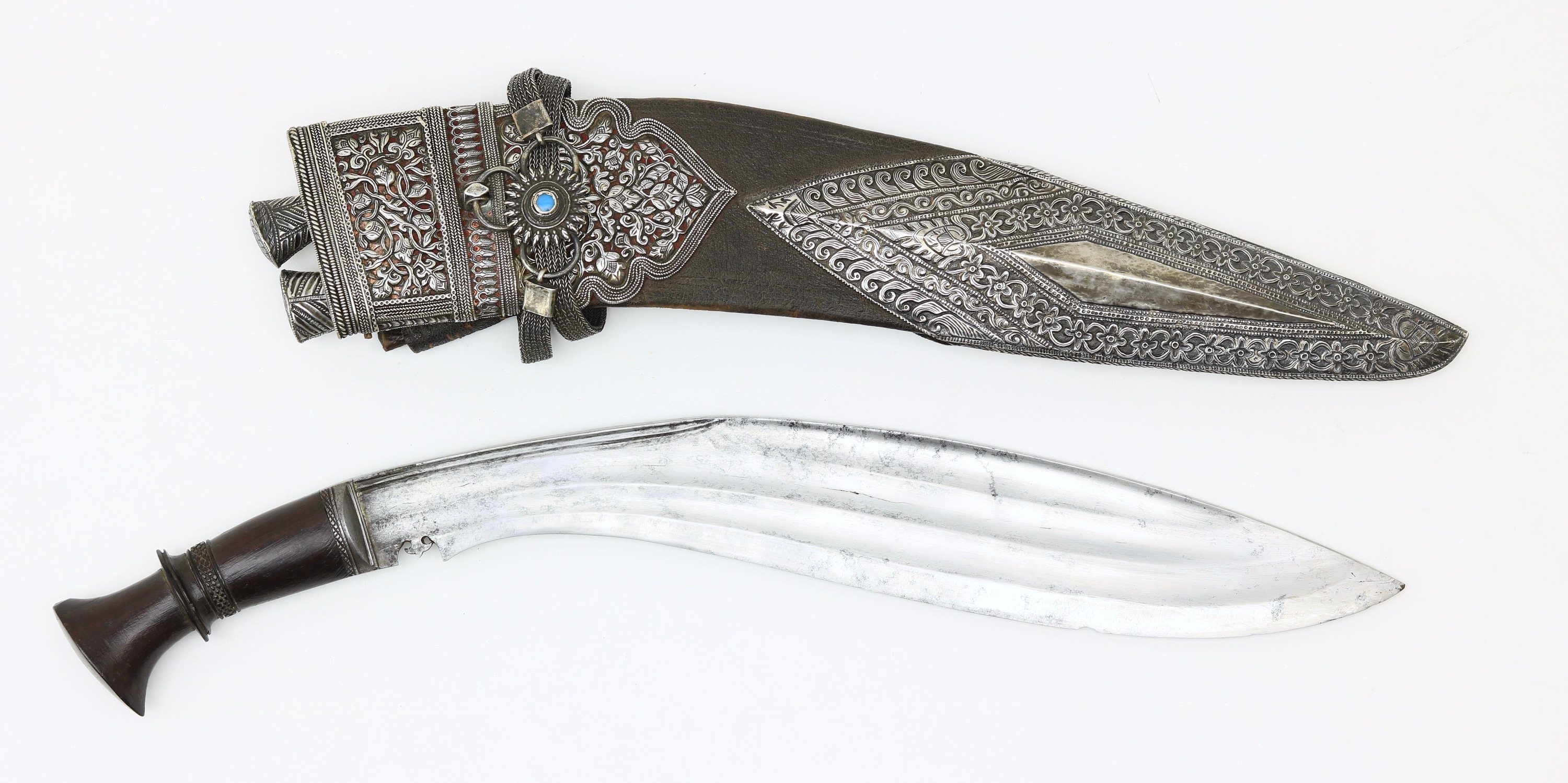 A fine late 19th century khukurī with silver mounts.
A fine late 19th century khukurī with silver mounts.
Listed by Mandarin Mansion in 2020.
Other terms
The knife goes by many names, but the best-established names and their romanization are khukurī (खुकुरी ) and the simpler khukri (खुक्रि), both appear in comparative and etymological dictionary of the Nepali language of 1931.1
The simplified word kukri is in common use today, mainly among English speaking collectors.
Notes
1. Sir Ralph Lilley Turner; A comparative and etymological dictionary of the Nepali language. London: K. Paul, Trench, Trubner, 1931.
Dated khukurī
Some of the earliest khukurī in existence are those belonging to Drabya Shah, housed in the National Museum of Nepal in Kathmandu which are thought to date from around 1559. The pieces in question though, appear to be misattributed and look late 18th / early 19th century instead. I will therefore not consider them as reference material.
18th century
The first few reliable images we get of early khukurī are two 18th century pieces, exhibiting striking similarities even though one is in a Chinese collection and the other was illustrated by an English expedition party.
First, an 18th-century khukurī that appears in the Palace Museum collection in Beijing.1 It was probably captured in battle or presented during the signing of a treaty during the Tibet-Ghurka conflicts of 1788-1792.

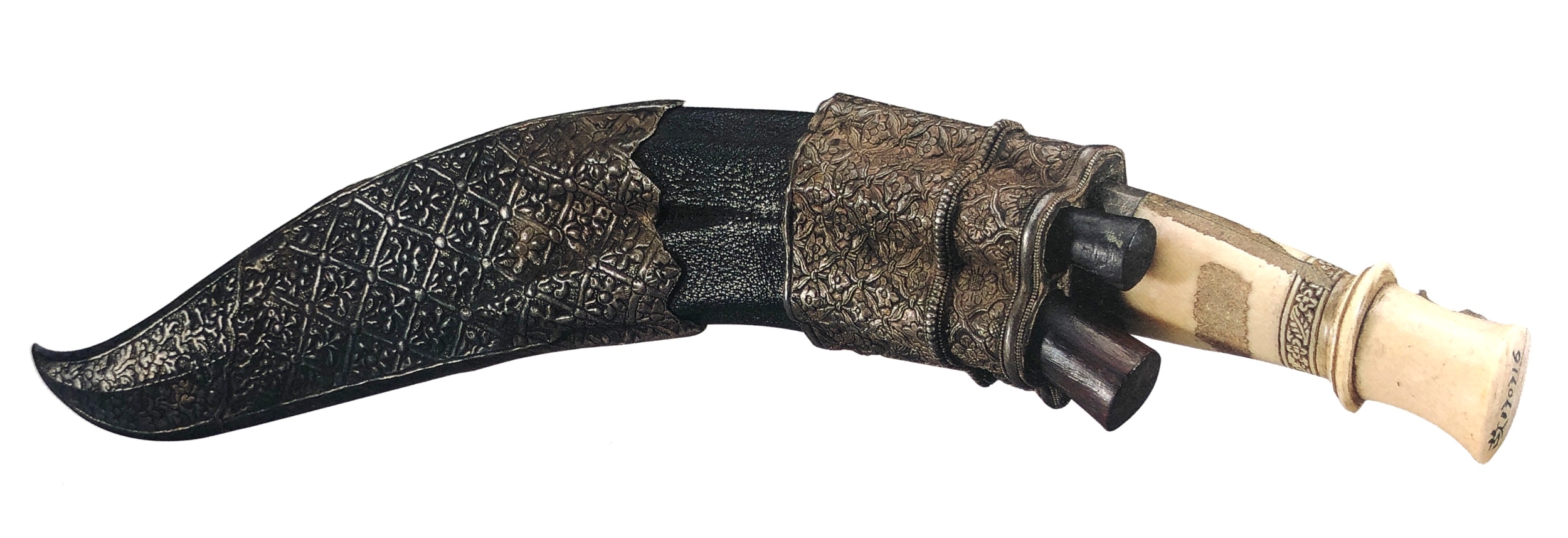
Khukurī in the Palace Museum collection, Beijing.
The relatively narrow handle with minimal flare in the pommel is also seen on Kirkpatrick's depiction of the khukurī, the first such illustration to appear in European sources. 2
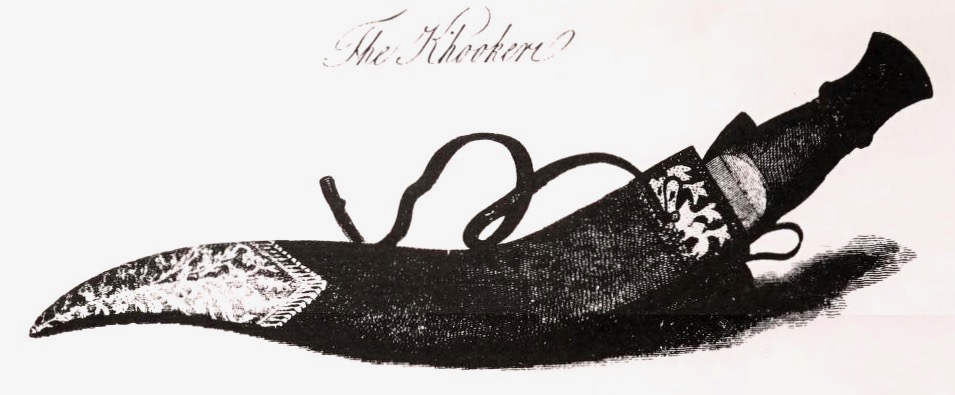
Early illustration of a khukurī.
From Colonel Kirkpatrick's 1793 account of Nepal.
Another early piece, most likely the late 18th century, was obtained by Lord Egerton in 1855. It was published in his book Indian and Oriental Arms and Armour and is now in the Victoria & Albert Museum. V&A accession number: 3095(IS).
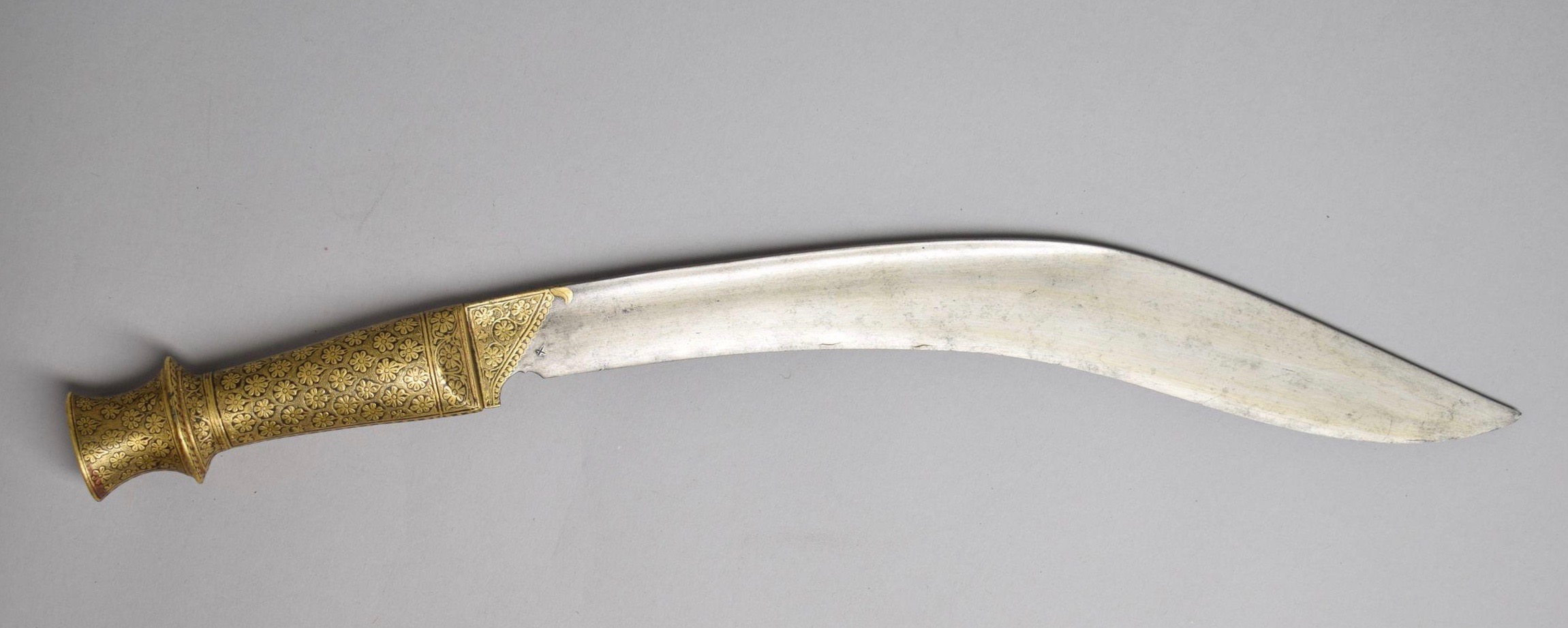
One of the Egerton khukurī
V&A accession number: 3095(IS).
This piece has some early features like the shallow kauro (notch), and the overall form of hilt and blade. The workmanship looks Indian, and it may have been made by Indian craftsmen.
19th century
Some well known early 19th-century depictions of khukurī are in the Fraser Album. A few of them were actually made, commissioned by William Fraser (1784-1835), a late Mughal era British India civil servant in Delhi.

"Eight Ghurkas" from the Fraser Album, published 1819.
Anonymous private collection.
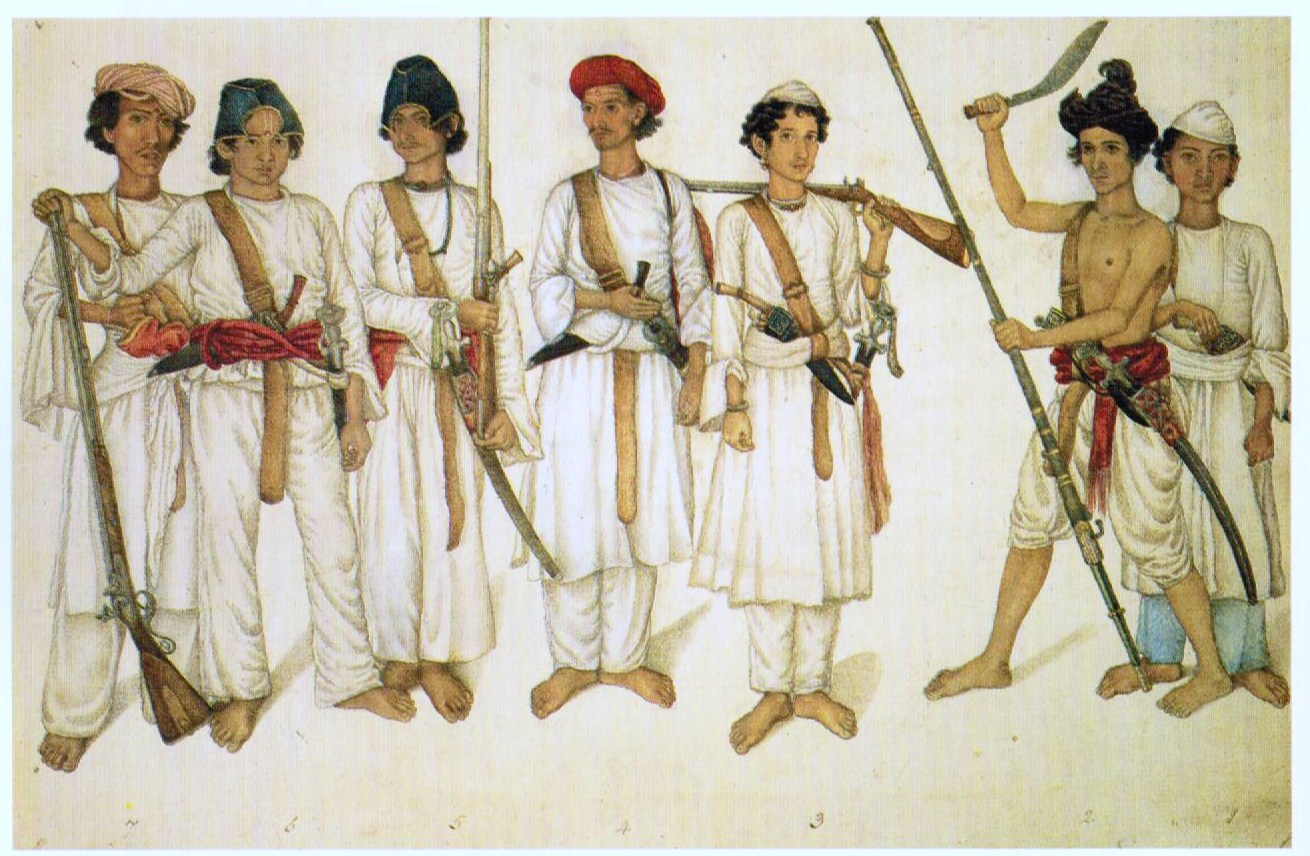
"Nepali soldiers" from the Fraser Album, published 1819.
Anonymous collection.

"A Ghurka soldier" from the Fraser Album, published 1819.
TAPI Collection.
Notable features seen on khukurī in these drawings are:
-Long hilts with gently flaring pommels
-Black enbroidered scabbards with small chape
-A recurved shape to the scabbard
Features that are all seen in a so-called "hanshee" khukurī in my collection:
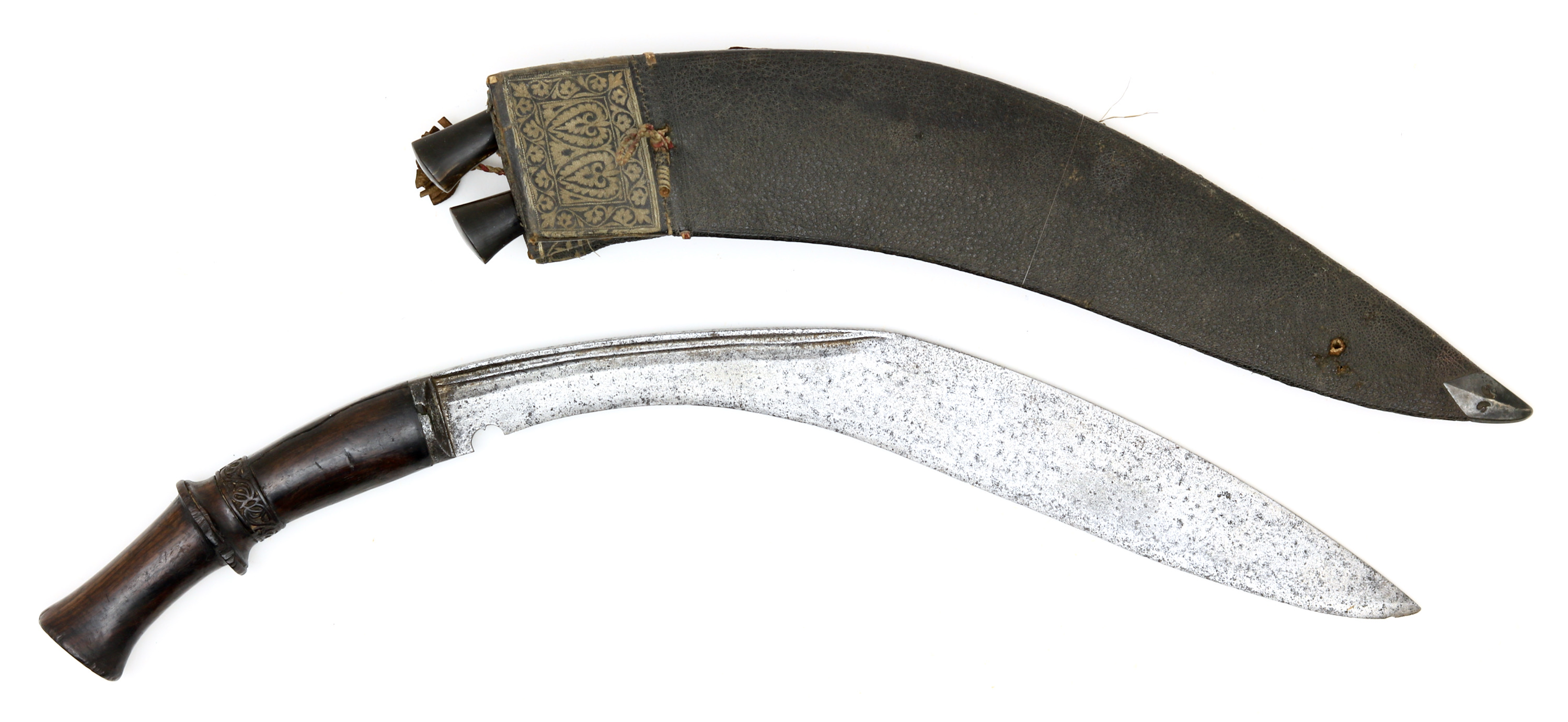
Hanshee khukurī. Probably 1800-1830.
Author's collection.
The embroidery is identical to that seen on a piece presented by the Late Sir Jung Bahadur to the East India Company, now in the Victoria & Albert Museum:
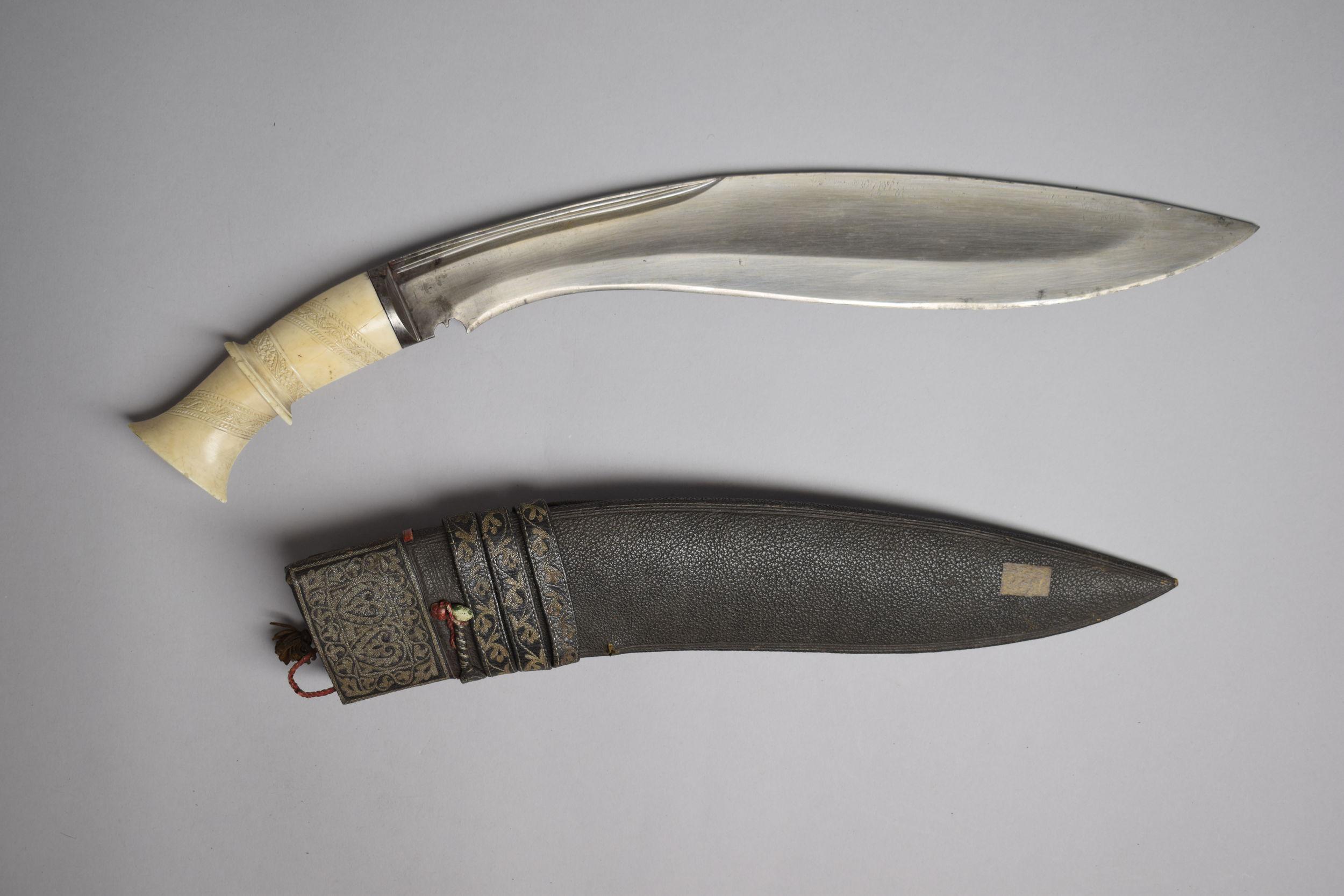
V&A accession number: 2561(IS).
Another group of well-provenanced khukurī are held in the Royal Collection Trust. I cannot share a direct link, but if you go to hwww.rct.uk/collection/search and type in "kukri" you will get to see 14 khukurī that were presented King Edward VII, when Prince of Wales, during his tour of India in 1875-76. This provenance tells us that they are at least from before the tour, but some seem quite a bit older than that.
Notes
1. See: Gugong Bowuyuan Cang Wenwu Zhenpin Quanji 56: Qing gong Wubei (故宫博物院藏文物珍品全集 56: 清宫武备) or "The Complete Collection of Treasures of the Palace Museum, Beijing 56: Armaments and Military Provisions", Palace Museum, Beijing. Published Hong Kong 2008. Page 151.
2. Colonel Kirkpatrick; Account Of The Kingdom Of Nepaul Being The Substance Of Observatons Made During A Mission To That Country In The Year 1793. W. Bulmer & Co, London, 1811. Pages 118-119.
3. Lord Egerton of Tatton; Indian and Oriental Arms and Armour. Dover Publications; Revised edition, 2002. Plate X and numbers 500, 501 and 504.
Historical anecdotes
"It is in felling small trees or shrubs, and lopping the branches of others for this purpose, that the dagger, or knife worn by every Nepaulian, and called Khookheri, is chiefly employed; it is also of very great use, as I repeatedly experienced, in clearing away the road when obstructed by the low hanging boughs of trees, and other similar impediments."
-William Kirkpatrick, 1811.
From: An Account of the Kingdom of Nepaul, narrative of an expedition of 1793.
"These irregular troops are commanded by Goorkali Sirdars. They are
clothed in uniform, but are armed, the same as the regulars, with muskets,
which are supplied by the Government. Some of them carry also swords,
and bows and arrows, and all of them wear in their girdles a large carved
knife, called a kookeree or boojalee, which serves as a culinary implement, as
well as a formidable weapon of offence.
In point of respectability or personal qualifications* these troops are far
inferior to the native Goorkas. In the latter respect, nature has drawn a very
striking difference ; for the slender form of the Kamaonese cannot be put in
competition with the stout Herculean limbs of the Goorkali soldier.
The privilege of wearing arms in this country is confined entirely to the
soldiery and to the officers of the Government: any other person would be
severely punished, who presumed to appear with an offensive weapon."
-Letter from Adjudant-General, Bengal, 27 Dec 1814.
From: Papers respecting the Nepaul war, 1824.
"The "kukri," the national weapon of the Nepaulese, is made principally at Bhera.
It is a large knife, with a short handle and an incurved blade,
widening in the middle, and drawing to a point at the end."
-Catalog of the Empire of India Exhibition, 1895.
"It appears a sepoy in passing a bush, in the very midst of which the elephants had been beating, trod on the leopard’s tail, so snugly was it hidden, and in one second it sprang on the man’s shoulders, biting his arm, and clawing him about the head. The Ghoorkas dropped their rifles, and with their kookries or knives, with out which no Ghoorka ever moves, they hacked the leopard almost to pieces on the man. As the beast fell off, Colonel Hicks, who had run up, put a ball through its head; but it was not needed, as it was already dead." *
-Colonel Fitz William Thomas Pollok, 1879
From: Sport in British Burmah, Assam, and the Cassyah and Jyntiah hills.
Notes to historical mentions
*. Colonel Fitz William Thomas Pollok; Sport in British Burmah, Assam, and the Cassyah and Jyntiah hills. Chapman and Hall, London. 1879. Volume 2. Page 40.
Possible origins
Khukurī appear to be part of a larger tradition of forward curving edged weapons from the Ottoman yatağan to the north Indian sosun patah. It seems plausible that all are distant relatives of the Greek kopis that were used by the armies of Alexander the Great.1
Its a theory that is not universally accepted, but we do know that there was a deep impact of the Greek presence in art and design in Asia, with and the emergence of Greco-Buddhist art that lead to the Buddha statues as we know them today.
Also, all dated swords and knives with a forward curve postdate Alexander's exploits, the shapes are not seen on any Indian art prior to Alexander's conquests. That said, there is still a lot of ground to be covered in researching the long period in-between. The khukurī is more closely related with curved swords seen on temple reliefs from Bengal, which is probably from where the idea of such a blade entered Nepal.
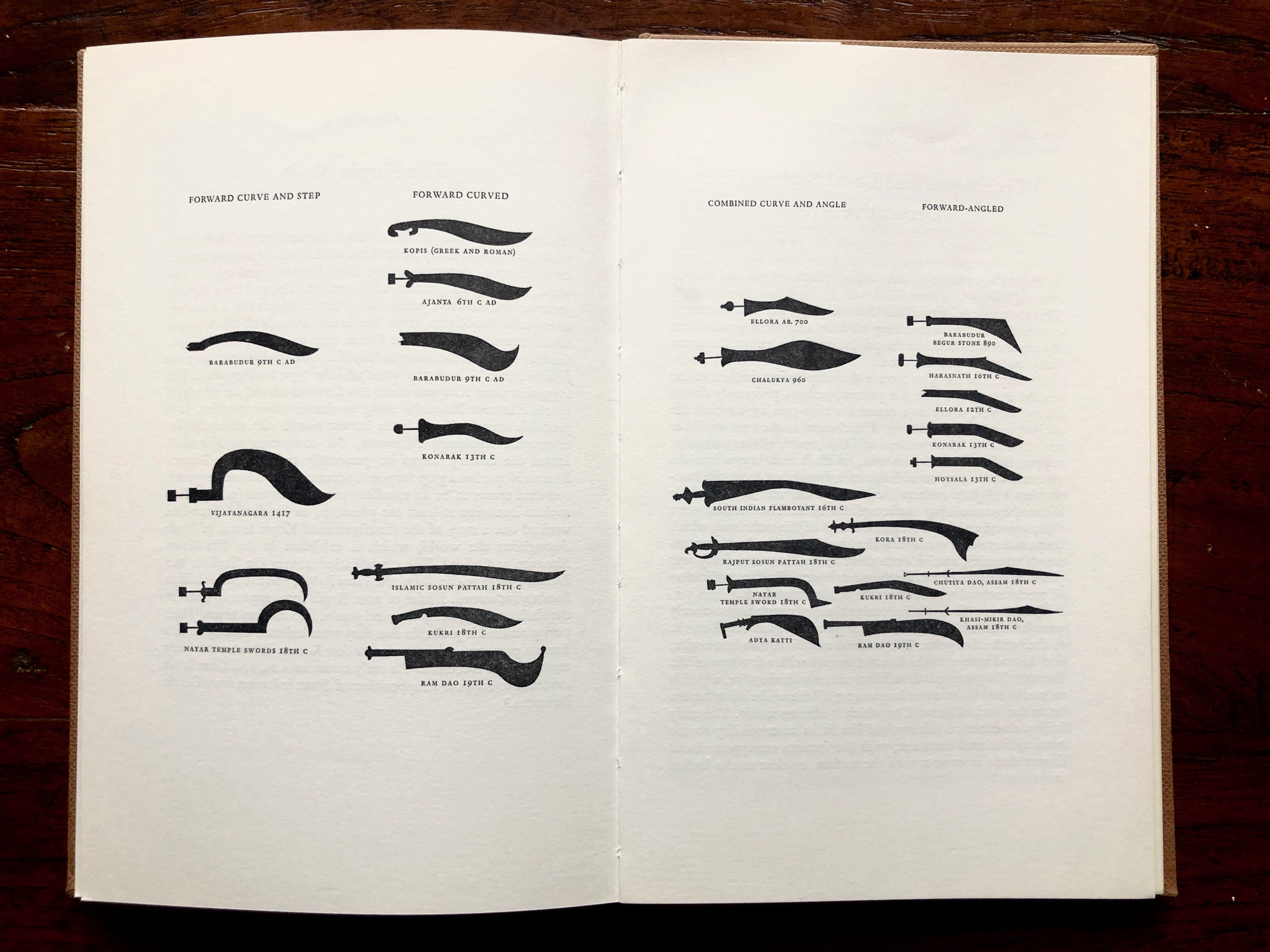
An overview of related swords, from Rawson.
Notes
1. Philip S. Rawson; The Indian Sword. Herbert Jenkins, London, 1968. Page 66.
Also see: A Nepalese khukurī glossary
Further reading:
Khukuri History by Benjamin Slade at himalayan-imports.com
Parts of John Powell's manuscript at kilatools.com




